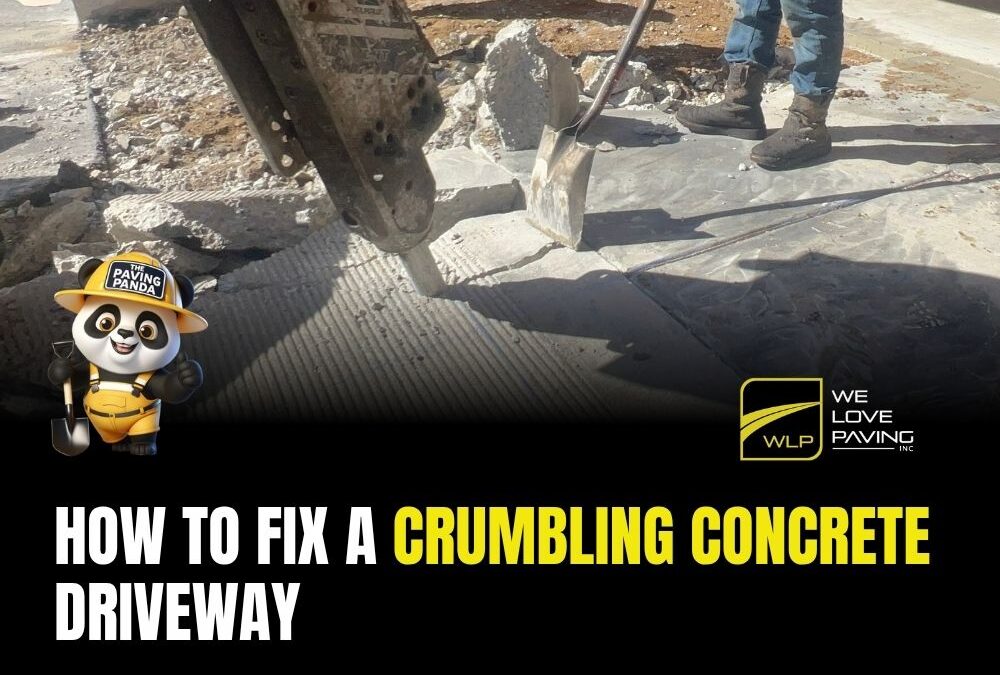When a concrete driveway starts to crumble, it’s more than a cosmetic issue — it’s a warning sign that the surface is losing its strength and integrity. Left untreated, it can lead to major damage, higher repair costs, and potential safety hazards. Whether you’re a homeowner or manage commercial properties, understanding how to repair a crumbling driveway can save you thousands over time.
🔍 Why Concrete Driveways Crumble
Concrete can deteriorate for several reasons. The most common causes include:
-
Freeze-thaw cycles: Water seeps into small cracks, freezes, expands, and breaks the concrete apart.
-
Poor installation: Weak concrete mix, lack of reinforcement, or an unstable base can cause early failure.
-
Heavy loads: Driveways not designed for large vehicles may start breaking under pressure.
-
Drainage issues: Standing water or erosion beneath the slab weakens its foundation.
-
Chemical damage: Salt, oil, and harsh cleaners can degrade concrete over time.
-
Aging: Even properly installed concrete loses resilience after many years.
🧰 Tools & Materials Needed
To repair a crumbling concrete driveway, you’ll need:
-
Hammer and chisel (or concrete saw)
-
Wire brush or stiff broom
-
Pressure washer or hose
-
Concrete bonding agent
-
Concrete resurfacer or patch mix (for horizontal surfaces)
-
Mixing bucket and trowel
-
Safety gear (gloves, goggles, mask)
-
Concrete sealer
✅ Step-by-Step Guide
Step 1: Assess the Damage
Walk the driveway and determine if the damage is surface-level or deeper.
-
If small flakes or thin layers are peeling off, resurfacing will work.
-
If large chunks are missing or the slab feels hollow, replacement may be necessary.
Step 2: Clean the Surface
Remove all dirt, debris, and crumbled material.
Use a pressure washer to clean thoroughly and allow the surface to dry before continuing.
Step 3: Remove Loose Concrete
Use your hammer and chisel to remove all loose, unstable pieces.
You need a solid edge and a clean surface for the new material to bond properly.
Step 4: Apply Bonding Agent
Once the surface is clean and dry, apply a concrete bonding agent to improve adhesion between old and new concrete.
Follow the product instructions for drying time before applying the repair mix.
Step 5: Mix and Apply the Resurfacer
Prepare the concrete patch or resurfacer according to the instructions.
-
Pour or trowel the mixture over the damaged areas.
-
Spread evenly using a trowel, feathering the edges to blend with existing concrete.
-
For deeper holes, apply in layers and allow partial setting between coats.
Step 6: Allow to Cure Properly
Let the repaired area cure according to the manufacturer’s recommendations.
Avoid driving or walking on it until it’s fully hardened.
Step 7: Seal the Driveway
After the concrete has cured, apply a high-quality concrete sealer.
This prevents water absorption, cracking, and damage from future freeze-thaw cycles.
🧠 Maintenance Tips to Prevent Future Damage
-
Sweep and clean the driveway regularly.
-
Fix small cracks as soon as they appear.
-
Reseal the surface every 2–3 years.
-
Ensure proper drainage to avoid water pooling.
-
Avoid using salt or harsh chemicals during winter.
👷 When to Call a Professional
Call a paving or concrete specialist if:
-
Large sections of the driveway are crumbling.
-
The base layer has shifted or eroded.
-
You see uneven sinking, heaving, or major cracks.
-
You need a long-term solution rather than a short patch job.
A professional can evaluate the cause, recommend the correct mix design, and ensure your repair lasts for years.
📝 Summary
Fixing a crumbling concrete driveway is completely doable with the right materials and preparation. The key steps are:
-
Clean and remove damaged concrete.
-
Apply a bonding agent and patch with a resurfacer.
-
Cure properly and seal the surface.
However, if the damage goes beyond surface wear, it’s worth investing in a professional inspection or a full replacement. A well-maintained driveway not only improves curb appeal — it also protects your property value.
🔍 Why Does Concrete Crumble?
Before jumping into repairs, it’s essential to know why the concrete is deteriorating. Common causes include:
-
Freeze-thaw cycles that force water into tiny cracks, freeze, expand and break the concrete apart. WE LOVE PAVING+2HomeMembership+2
-
Heavy loads or constant traffic that exceed the original design of the driveway. WE LOVE PAVING+1
-
Poor installation (weak mix, insufficient reinforcement, inadequate base/subgrade). WE LOVE PAVING+1
-
Water damage and erosion of the underlying base/subgrade, which compromises support. Reddit+1
-
Aging and surface wear: over time, even good concrete loses resilience. WE LOVE PAVING+1
Critical note (to you, Miguel): Si la crumbling es muy profunda o extendida, el parche puede no ser suficiente — podría requerir reemplazo completo del tramo afectado. No “vende” barato si el daño es grave.
🧰 Tools & Materials Needed
-
Chisel & hammer (to remove loose concrete)
-
Wire brush or stiff broom
-
Pressure washer or garden hose (for cleaning)
-
Concrete resurfacer or repair mix / patching mortar
-
Concrete bonding agent (for better adhesion)
-
Trowel & mixing bucket
-
Safety gear: gloves, safety glasses, dust-mask
-
Sealer (to protect the repaired surface from future damage)
These align with typical advice from DIY and professional sources. WE LOVE PAVING+1
✅ Step-by-Step Repair Guide
Step 1: Assess the Damage
-
Visually inspect the driveway. Is the deterioration only surface-level (spalling, small crumbles) or has the damage penetrated deeper (large chunks missing, the slab “hollow” underneath)? WE LOVE PAVING+1
-
If multiple large sections are failing, or if the base is undermined, you may need professional assessment and possibly removal and repour. (Again: don’t under-sell this risk.)
Step 2: Clean & Prepare the Surface
-
Remove all debris, dirt, moss, oil stains. Use a pressure washer if available. ics50.com+1
-
Chisel out any loose, crumbling pieces of concrete. It’s vital to have a sound base for the new material to bond. WE LOVE PAVING+1
-
Ensure the surface is dry (moisture will reduce bonding strength).
Step 3: Apply Bonding Agent (if needed)
-
If the repair material requires it, apply a concrete bonding agent on the cleaned surface to improve adhesion of new to old. ics50.com
Step 4: Repair & Resurface
-
Use a concrete resurfacer or patching mix designed for horizontal surfaces (driveways) and heavy loads. ics50.com+1
-
Mix according to manufacturer instructions. Apply with a trowel, filling voids, smoothing edges, blending new material into the existing surface. WE LOVE PAVING
-
For deeper voids: you may need to apply in layers, allowing each to set slightly before topping.
Step 5: Cure and Protect
-
Allow the repair to cure properly — often involves keeping the surface moist for a period (as directed by repair material). WE LOVE PAVING
-
After curing, apply a quality concrete sealer to protect against water intrusion, freeze-thaw damage, chemicals, and wear. WE LOVE PAVING
Step 6: Maintenance & Prevention
-
Sweep/clean regularly to remove salts, oils, debris. HomeMembership
-
Repair small cracks early (before they widen) to avoid them evolving into crumbling sections.
-
Ensure drainage is correct: water should not pool on or under the concrete.
-
Avoid exceeding the load capacity of the driveway (especially if heavy vehicles are involved) unless the slab was designed for that.
-
Seal or re-seal every few years to prolong life.
🔍 When to Call a Professional
Even though many homeowners can handle minor repairs, you should call a professional when:
-
There are large sunken or hollow slabs (indicating subgrade failure or undermining). Reddit
-
The crumbling is extensive and covers large areas (i.e., more than superficial).
-
You suspect structural defects like poor base, alkali–silica reaction (ASR) or recurring failure despite previous repairs.
-
You intend to repour large sections and need permits, reinforcement, or professional mix design.
📝 Summary
Repairing a crumbling concrete driveway is entirely feasible — if you properly prepare the site, use appropriate materials, and follow good technique. Keep in mind: skipping the preparation or using inferior materials often leads to only short-term fixes. If you see the damage is systemic, invest in a full replacement rather than repeating patches.

